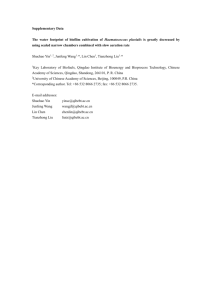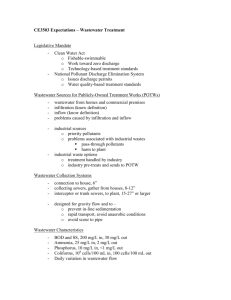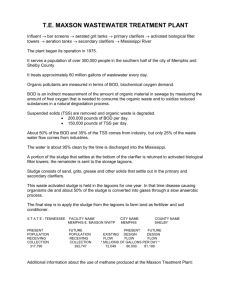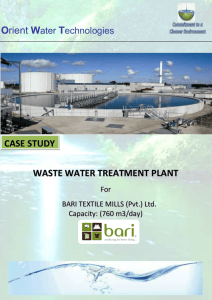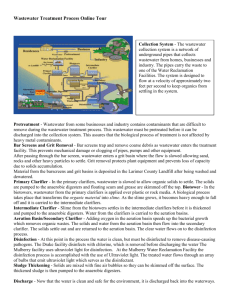White Paper - Treatment Plant Operator
advertisement
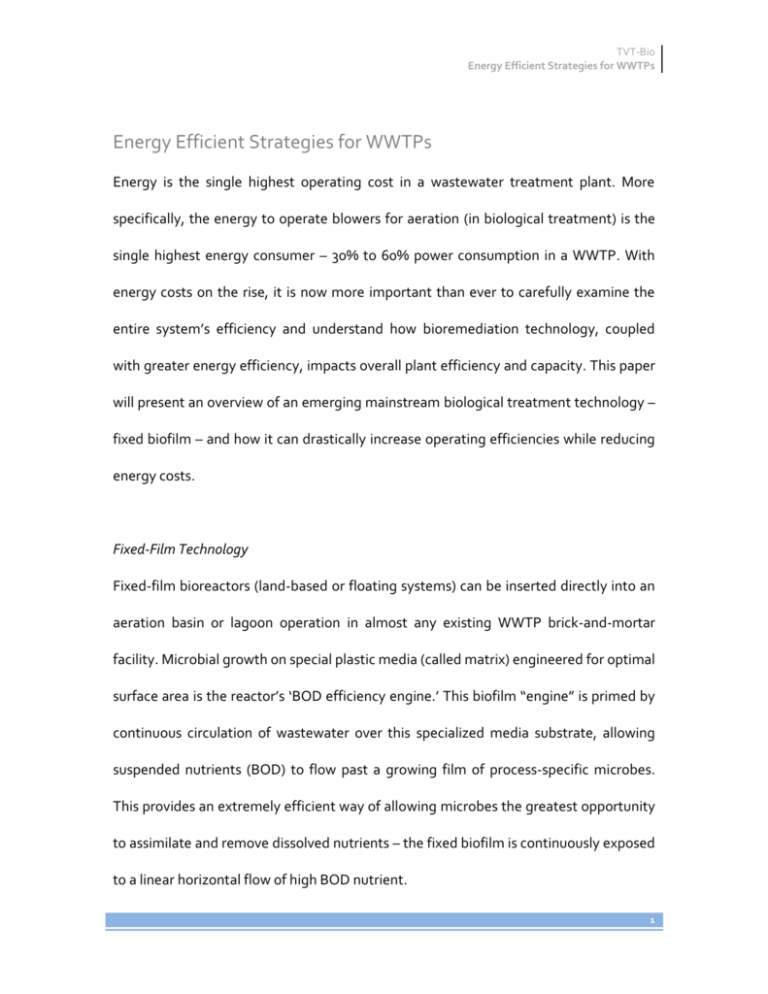
TVT-Bio Energy Efficient Strategies for WWTPs Energy Efficient Strategies for WWTPs Energy is the single highest operating cost in a wastewater treatment plant. More specifically, the energy to operate blowers for aeration (in biological treatment) is the single highest energy consumer – 30% to 60% power consumption in a WWTP. With energy costs on the rise, it is now more important than ever to carefully examine the entire system’s efficiency and understand how bioremediation technology, coupled with greater energy efficiency, impacts overall plant efficiency and capacity. This paper will present an overview of an emerging mainstream biological treatment technology – fixed biofilm – and how it can drastically increase operating efficiencies while reducing energy costs. Fixed-Film Technology Fixed-film bioreactors (land-based or floating systems) can be inserted directly into an aeration basin or lagoon operation in almost any existing WWTP brick-and-mortar facility. Microbial growth on special plastic media (called matrix) engineered for optimal surface area is the reactor’s ‘BOD efficiency engine.’ This biofilm “engine” is primed by continuous circulation of wastewater over this specialized media substrate, allowing suspended nutrients (BOD) to flow past a growing film of process-specific microbes. This provides an extremely efficient way of allowing microbes the greatest opportunity to assimilate and remove dissolved nutrients – the fixed biofilm is continuously exposed to a linear horizontal flow of high BOD nutrient. 1 TVT-Bio Energy Efficient Strategies for WWTPs Biofilm processes provide a more stable performance and efficiency platform compared to conventional activated sludge systems. An additional advantage is that denitrification proceeds even under aerobic conditions due to the presence of an anaerobic zone in the lower layer of the biofilm. Consequently, simultaneous nitrification and denitrification in the same film can be expected. The unique design of TVT Bio-Reactors exploits this condition and allows the existing microbiology to use nitrate to oxidize waste BOD – better controlling solids retention time (SRT) saving energy. Increased Surface area = Greater BOD Efficiency A bioreactor media matrix has more than double the surface area of trickling filter material (30 ft2/ft3 compared to traditional rock matrix at 15 ft2/ft3). As biofilm builds up on this matrix, the round surfaces of the matrix in contact with the wastewater increase geometrically with the thickness of the biofilm – within weeks! The ever-growing biofilm explodes the effective bio-active surface to 60 to 90 ft2/ft3. Such ‘bioamplification’ augments the existing system microbiology allowing great flexibility in handling changing BOD loading. Maximum contact frequency and microbial productivity is the ‘heart’ of the BOD engine – efficiently providing the most nutrients to the largest number of microbes. As the 2 TVT-Bio Energy Efficient Strategies for WWTPs biofilm grows, cell densities logarithmically increase from traditional 104 levels to 109/mL. Laminar Flow Creates Scouring Sludge Velocities Placed within an existing WWTP aeration tank or lagoon, the TVT-Bioreactor utilizes a submerged laminar flow design coupled with air injection (coarse and fine-bubble diffusion) to achieve a more-efficient continuous delivery of nutrient-laden wastewater to the growing biofilm. This patented aeration system allows maximum diffusion (120 lbs DO/d) at the water-biofilm interface. It also creates a more horizontal laminar flow plume condition as opposed to the stratified; diffuse conditions usually present in aeration basins. This unique laminar flow condition creates velocities that will horizontally scour existing settled sludges in an aeration basin reducing sludge volume and decreasing RAS levels. Process efficiency gradually increases over a 2 to 4 month period – removing a minimum 1320 lb/D BOD per reactor. Water Column Inoculation One consequence of incorporation of a bioreactor into an aeration basin or lagoon is that turbulence-induced sloughing of biologically-active floc particles off the reactor substrate, and exiting the reactor, will essentially ‘inoculate’ the surrounding water column with process-specific microbiology. This is the bio-augmentation “efficiency- 3 TVT-Bio Energy Efficient Strategies for WWTPs multiplier’ allowing for increased facility capacity within an existing brick-and-mortar facilities. Efficiency Is Less Energy Expensive Bubble size matters! Small, fine bubbles (Table 1) are more energy and biological process efficient than coarse bubbles. Traditional activated sludge aeration equipment uses larger horsepower motors and multiple units (blowers and surface aerators). All too often, oversized blowers are installed that must be operated at less than 50 percent of their designed capacity using variable speed drives or throttling air flows just to maintain a DO level in the 4 to 5 mg/l (ideal range is 1.5 to 2.0 mg/l). The inefficiency of operating an aeration system at high DO levels is compounded by the poor mechanical efficiency of some blowers at reduced outputs. One of the single greatest factors that can provide the most cost effective energy savings impact for a facility is applying an automatic control system. For aeration systems, dissolved oxygen probes and analyzers are the most commonly used instruments to measure the level of dissolved oxygen in the wastewater and provide a variable signal to adjust air flow. 4 TVT-Bio Energy Efficient Strategies for WWTPs The TVT-Reactor’s unique aeration process-control efficiencies (bubble turbulence), SRT reduction, decreasing RAS, and maintenance of an efficient DO concentration of 2mg/L can add up to increased BOD load capacity and significant power savings! A single TVT-Bioreactor has an electrical load factor of 45 amps. Energy savings approaching 55% are possible with an augmented bio-reactor installation. TABLE 1 Diffuser Type and Placement Coarse Bubble Diffusers1 Oxygen Transfer Rate lb O2/ hp-hr 2.0 Fine Bubble Diffusers2 Surface Mechanical Aerators Submerged Turbine Aerators3 Jet Aerators4 6.5 3.0 2.0 2.8 1 For 2.7 – 3.6m (9-12’) submergence – 26 w/m3 (0.7 – 1.0 hp-hr/100ft3 3 Includes blower and mixer horsepower 4 Includes both blower and pump horsepower SOURCE: EPA, 1989 2 For 18 Case Study TVT-Bio was tasked with reducing energy costs, increasing treatment capacity, and increasing existing brick and mortar processing efficiencies by providing a fixed biofilm solution that accommodated highly variable BOD levels. 5 TVT-Bio Energy Efficient Strategies for WWTPs At a glance … A wastewater treatment plant in upstate New York needed to increase treatment capacity. The wastewater treatment plant consisted of a series of concrete lined circular ponds. A headworks was followed by the equalization/mixing basin, followed by two long-retention, activated sludge ponds, followed by two clarifiers, and finally a sand filter. The daily inflow is 32,000 gpd with peak loads up to 90,000 gpd. Pond 1, the equalization/ mixing pond has a diameter of 72’, pond 2, the first activated sludge pond has also a diameter of 72’, and pond 3, also activated sludge, has a diameter of 90’. The activated sludge empties into both clarifiers and from there is passed through the sand filter to be finally discharged into a trout stream. NY WWTP Plant Capacity 96,000 G Average Flows 35,000GPD COD 1,000+ mg/L BODinf 1501 mg/L BODef 35 mg/L Detention time 30D Energy 150hp Consumption Daily Energy Use 2285kw A 32’ tubular bioreactor was installed in the 96,000 G primary lagoon in 2 hours. Over an operational period of 10 months, the following effects were realized: Significant odor reduction Increased circulation – 11X / 24 hr. 6 TVT-Bio Energy Efficient Strategies for WWTPs Decreased detention time (30 D to 1D) Increased flocculation, decreased foaming 42% reduction in energy consumption (150hp to a max of 86.5hp) Daily energy usage reduced to 1243kw What Can a Bio-Reactor Retrofit Do for You? The case study demonstrates a 40% reduction in energy costs in addition to an 80% BOD reduction. Visit our website www.TVT-bio.com, enter facility data, and see what a bio-reactor can do for you! USEPA., (1989), “Design Manual - Fine Pore Aeration Systems”, Center for Environmental Research, Cincinnati, Ohio 7
